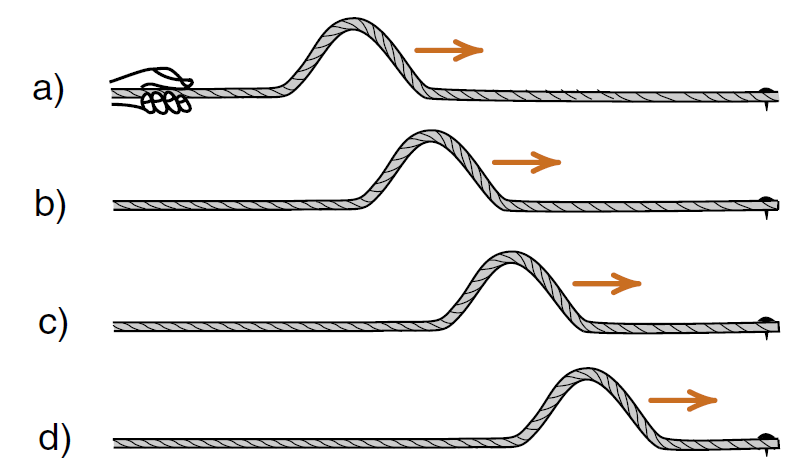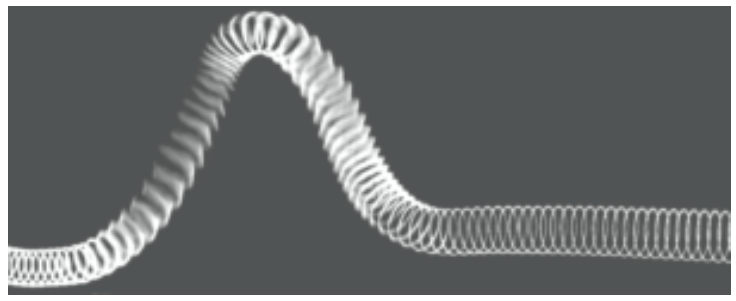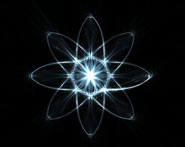


 الفيزياء الكلاسيكية
الفيزياء الكلاسيكية
 الكهربائية والمغناطيسية
الكهربائية والمغناطيسية
 علم البصريات
علم البصريات
 الفيزياء الحديثة
الفيزياء الحديثة
 النظرية النسبية
النظرية النسبية
 الفيزياء النووية
الفيزياء النووية
 فيزياء الحالة الصلبة
فيزياء الحالة الصلبة
 الليزر
الليزر
 علم الفلك
علم الفلك
 المجموعة الشمسية
المجموعة الشمسية
 الطاقة البديلة
الطاقة البديلة
 الفيزياء والعلوم الأخرى
الفيزياء والعلوم الأخرى
 مواضيع عامة في الفيزياء
مواضيع عامة في الفيزياء|
Read More
Date: 13-7-2017
Date: 12-9-2020
Date: 12-12-2016
|
WAVE PULSES
To create a wave pulse on a stretched rope, you flick the end of the rope and a pulse travels down the rope as shown in Figure (1) reproduced here. This is called a transverse wave because the particles in the rope move perpendicular or transverse to the direction of motion of the wave pulse.
With a stretched Slinky we were able to observe two different kinds of wave motion, the transverse wave seen in Figure (2) and a compressional wave seen in Figure (3). The compressional wave is also called a longitudinal wave because the particles in the spring

Figure 1: Wave traveling down a rope.

Figure 2: Transverse wave on a Slinky

Figure 3: Compressional wave on a Slinky.
are moving longitudinally or parallel to the direction of motion of the wave pulse.
Sound waves are usually compressional waves traveling through matter. A sound wave pulse in air can be viewed as a region of compressed gas where the molecules are closer together as shown in Figure (1). It is the region of compression that moves through the gas in much the same way as the region of compressed coils moves along the Slinky as seen in Figure (3).
To create the compressional wave on the Slinky we pulled back on the end of the Slinky and let go. This gives a small impulse directed down the Slinky. In much the same way we can use a loudspeaker cone to create the pressure pulse in the air column of Figure (4). Here the impulse can be provided by applying a voltage pulse to the speaker causing the speaker cone to suddenly jump forward. (If the speaker cone suddenly jumps back, you get a pulse consisting of a region of low pressure traveling down the tube.)
A transverse or sideways force in the medium tends to restore the medium to its original shape. For a transverse wave on a stretched rope, the tension on the rope provides the restoring force. For waves on the surface of a liquid, gravity or surface tension supplies the restoring force. But for waves passing through the bulk of a liquid or a gas, there are no transverse restoring forces and the only kind of waves we get are the compressional sound waves.

Figure 4: A sound wave pulse traveling down through a tube of air. The pulse consists of a region of compressed air where the air molecules are closer together. This region of compression moves through the gas much as the region of compressed coils moves along the Slinky in Figure 3.
The main difference between a liquid and a solid is that in a liquid the molecules can slide past each other, while in a solid the molecules are held in place by molecular forces. These forces which prevent molecules from sliding past each other can also supply a transverse restoring force allowing a solid to transmit both transverse and compressional waves. An earthquake, for example, is a sudden disruption of the earth that produces both transverse waves called S waves and longitudinal or compressional waves called P waves. These waves can easily be detected using a device called a seismograph which monitors the vibration of the earth. It turns out that the S and P waves from an earthquake travel at different speeds, and will thus arrive at a seismometer at different times. By measuring the difference in arrival time and knowing the speed of the waves, you can determine how far away the earthquake was.



|
|
|
|
لشعر لامع وكثيف وصحي.. وصفة تكشف "سرا آسيويا" قديما
|
|
|
|
|
|
|
كيفية الحفاظ على فرامل السيارة لضمان الأمان المثالي
|
|
|
|
|
|
|
جامعة الكفيل تطلق الامتحانات النهائية لطلبتها
|
|
|